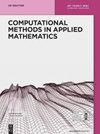热方程的时间自适应时空FMM
IF 1.2
4区 数学
Q3 MATHEMATICS, APPLIED
引用次数: 0
摘要
摘要我们为热方程的时空边界元方法提出了一种新的时间自适应FMM。该方法通过添加新的运算来扩展现有的抛物型FMM,这些运算允许对时间自适应的张量积网格进行有效处理。我们分析了新运算的效率和相关核展开的近似质量,并通过数值实验揭示了新方法的优点。本文章由计算机程序翻译,如有差异,请以英文原文为准。
A Time-Adaptive Space-Time FMM for the Heat Equation
Abstract We present a new time-adaptive FMM for a space-time boundary element method for the heat equation. The method extends the existing parabolic FMM by adding new operations that allow for an efficient treatment of tensor product meshes which are adaptive in time. We analyze the efficiency of the new operations and the approximation quality of the related kernel expansions and present numerical experiments that reveal the benefits of the new method.
求助全文
通过发布文献求助,成功后即可免费获取论文全文。
去求助
来源期刊

Computational Methods in Applied Mathematics
MATHEMATICS, APPLIED-
CiteScore
2.40
自引率
7.70%
发文量
54
期刊介绍:
The highly selective international mathematical journal Computational Methods in Applied Mathematics (CMAM) considers original mathematical contributions to computational methods and numerical analysis with applications mainly related to PDEs.
CMAM seeks to be interdisciplinary while retaining the common thread of numerical analysis, it is intended to be readily readable and meant for a wide circle of researchers in applied mathematics.
The journal is published by De Gruyter on behalf of the Institute of Mathematics of the National Academy of Science of Belarus.
 求助内容:
求助内容: 应助结果提醒方式:
应助结果提醒方式:


